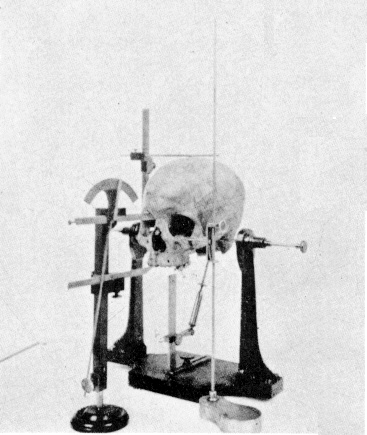
頭蓋計測
Craniometry
A
human skull and measurement device from 1902
☆ 頭蓋計測学(Craniometry) とは、頭蓋(頭蓋骨の主要部分)の計測であり、通常は人間の頭蓋を計測する。頭部計測学の一部であり、人間の場合は人体計測学の一部である。頭蓋計測学 は、頭の形から性格や人格を類推しようとした疑似科学である骨相学や、顔の特徴から性格や人格を類推しようとした人相学とは異なる。 今日では、自然人類学者や法医学人類学者が頭蓋計測学を用いて、人類集団の進化を研究したり、ケネウィック・マンなどの古代遺跡の起源を特定したり、法執 行機関による死亡者の人種特定に役立てている。 法医学法医学人類学者は、頭蓋計測データ、使用する変数の数、母集団、分析の種類によって、個人の認識されている社会的人種を81~99%の精度で正確に 特定することができる。 法医学人類学者と生物人類学者の間では、頭蓋計測学における人種の使用に関して意見の相違があり、生物人類学者は生物学的人種に関するあらゆる理論を否定 しようとしているが、法医学人類学者の多くは社会的に作られた人種カテゴリーに基づいて事実調査を行っている。19世紀から20世紀前半にかけて、身体人 類学ではこの手法が盛んに行われていた。人種に基づく社会の隔離を科学的に正当化しようとする理論がこの時代に広まったが、その著名な人物の一人にジョル ジュ・ヴァシェール・ド・ラプージュ(1854年~1936年)がおり、彼は人類をさまざまな階層化された異なる「人種」に分類した (古代ギリシャ語の「頭」を意味する「kephalê」と「細長い」を意味する「dolikhos」に由来する)から、「短頭種」(頭が短く幅広)の種ま で、さまざまなヒエラルキー化された「人種」に分類した。一方で、頭蓋計測学は「北方人種」の存在を否定する証拠としても用いられ、また、フランツ・ボア ズは頭部指数を用いて環境要因の影響を示した。チャールズ・ダーウィンは、種の起源(1859年)で初めて示した進化論を立証するために、頭蓋測定法と骨 格の研究を用いた。 全く別の目的で、15世紀以降の芸術家たちは、人体の頭部や頭蓋骨をより正確に表現するために、それらの測定を行っていた。ベルナール・パリーシーやアル ブレヒト・デューラーは、そのような研究の先駆者であった。
Engraving of craniometer from Elements of phrenology (1835), by George Combe
| Craniometry is
measurement of the cranium (the main part of the skull), usually the
human cranium. It is a subset of cephalometry, measurement of the head,
which in humans is a subset of anthropometry, measurement of the human
body. It is distinct from phrenology, the pseudoscience that tried to
link personality and character to head shape, and physiognomy, which
tried the same for facial features. Today, physical and forensic anthropologists use craniometry to study the evolution of human populations, determining the origin of ancient remains such as the Kennewick Man, or helping law enforcement to identify the race of the deceased.[1][2][3] Forensic anthropologists can correctly identify the perceived social race of an individual with rates from 81-99% accuracy depending on the craniometric data, the number of variables used, the populations, and the type of analysis.[4][5][6] There is a rift between forensic and biological anthropologists in the use of race in craniometry, with biological anthropologists attempting to disprove any theory of biological race, compared to how many forensic anthropologists make factual inquiries based on societally-created racial categories.[7] It was once intensively practised in physical anthropology in the 19th and the first part of the 20th century. Theories attempting to scientifically justify the segregation of society based on race became popular at this time, one of their prominent figures being Georges Vacher de Lapouge (1854–1936), who divided humanity into various, hierarchized, different "races", spanning from the "Aryan white race, dolichocephalic" (from the Ancient Greek kephalê, head, and dolikhos, long and thin), to the "brachycephalic" (short and broad-headed) race. On the other hand, craniometry was also used as evidence against the existence of a "Nordic race" and also by Franz Boas who used the cephalic index to show the influence of environmental factors. Charles Darwin used craniometry and the study of skeletons to demonstrate his theory of evolution first expressed in On the Origin of Species (1859). Quite separately, certain artists from the 15th century onward made measurements of heads and skulls with a view to attaining greater accuracy in their representation of those parts of the human frame. Bernard Palissy and Albrecht Dürer were pioneers in such researches.[8] |
頭蓋計測学とは、頭蓋(頭蓋骨の主要部分)の計測であり、通常は人間の
頭蓋を計測する。頭部計測学の一部であり、人間の場合は人体計測学の一部である。頭蓋計測学は、頭の形から性格や人格を類推しようとした疑似科学である骨
相学や、顔の特徴から性格や人格を類推しようとした人相学とは異なる(→「現代の骨相学とゲノムサイエンス」)。 今日では、自然人類学者や法医学人類学者が頭蓋計測学を用いて、人類集団の進化を研究したり、ケネウィック・マンなどの古代遺跡の起源を特定したり、法執 行機関による死亡者の人種特定に役立てている。[1][2][3] 法医学 法医学人類学者は、頭蓋計測データ、使用する変数の数、母集団、分析の種類によって、個人の認識されている社会的人種を81~99%の精度で正確に特定す ることができる。 法医学人類学者と生物人類学者の間では、頭蓋計測学における人種の使用に関して意見の相違があり、生物人類学者は生物学的人種に関するあらゆる理論を否定 しようとしているが、法医学人類学者の多くは社会的に作られた人種カテゴリーに基づいて事実調査を行っている。[7] 19世紀から20世紀前半にかけて、身体人類学ではこの手法が盛んに行われていた。人種に基づく社会の隔離を科学的に正当化しようとする理論がこの時代に 広まったが、その著名な人物の一人にジョルジュ・ヴァシェール・ド・ラプージュ(1854年~1936年)がおり、彼は人類をさまざまな階層化された異な る「人種」に分類した (古代ギリシャ語の「頭」を意味する「kephalê」と「細長い」を意味する「dolikhos」に由来する)から、「短頭種」(頭が短く幅広)の種ま で、さまざまなヒエラルキー化された「人種」に分類した。 一方で、頭蓋計測学は「北方人種」の存在を否定する証拠としても用いられ、また、フランツ・ボアズは頭部指数を用いて環境要因の影響を示した。チャール ズ・ダーウィンは、種の起源(1859年)で初めて示した進化論を立証するために、頭蓋測定法と骨格の研究を用いた。 全く別の目的で、15世紀以降の芸術家たちは、人体の頭部や頭蓋骨をより正確に表現するために、それらの測定を行っていた。ベルナール・パリーシーやアル ブレヒト・デューラーは、そのような研究の先駆者であった。[8] |
| The cephalic index Main article: Cephalic index Swedish professor of anatomy Anders Retzius (1796–1860) first used the cephalic index in physical anthropology to classify ancient human remains found in Europe. He classified brains into three main categories, "dolichocephalic" (from the Ancient Greek kephalê, head, and dolikhos, long and thin), "brachycephalic" (short and broad) and "mesocephalic" (intermediate length and width). A similar classification was the vertical cephalic index, the categories of which were "chamaecranic" (low-skulled), "orthocranic", (medium high-skulled), and "hypsicranic" (high-skulled). These terms were then used by Georges Vacher de Lapouge (1854–1936), one of the founders of pseudo-scientific theories in this area and a theoretician of eugenics, who in L'Aryen et son rôle social (1899 – "The Aryan and his social role") divided humanity into various, hierarchized, different "races", spanning from the "Aryan white race, dolichocephalic", to the "brachycephalic" "mediocre and inert" race, best represented by the population of "France, Spain, Italy, all of Asia, and most of the Slavic countries" Hecht, Jennifer Michael (2003). The end of the soul: scientific modernity, atheism, and anthropology in France. New York: Columbia University Press. p. 171. ISBN 978-0231128469. Between these, Vacher de Lapouge identified the "Homo europaeus" (Teutonic, Protestant, etc.), the "Homo alpinus" (Auvergnat, Turkish, etc.), and finally the "Homo mediterraneus" (Napolitano, Andalus, etc.). "Homo africanus" (Congo, Florida) was even excluded from the discussion. Vacher de Lapouge became one of the leading inspirations of Nazi antisemitism and Nazi ideology.[9] His classification was mirrored in William Z. Ripley in The Races of Europe (1899). |
頭部指数 詳細は「頭部指数」を参照 スウェーデンの解剖学者アンデシュ・レティウス(Anders Retzius、1796年-1860年)は、ヨーロッパで発見された古代の人骨を分類するために、自然人類学において初めて頭部指数を用いた。彼は脳を 3つの主なカテゴリー、「長頭型」(古代ギリシャ語のkephalê(頭)とdolikhos(細長い)に由来する)、「短頭型」(短く幅広)、「中頭 型」(長さと幅が中程度)に分類した。 同様の分類として、頭部縦長指数というものがあり、そのカテゴリーは「頭蓋底型」(頭蓋が低い)、「正中頭型」(頭蓋が中程度)、「頭蓋高型」(頭蓋が高い)であった。 これらの用語は、この分野における疑似科学理論の創始者の一人であり、優生学の理論家でもあるジョルジュ・ヴァシェール・ド・ラプージュ(1854年 ~1936年)によって使用された。ラプージュは著書『アーリア人とその社会的役割』(1899年)の中で、人類をさまざまな階層化された「人種」に分類 し、 ヒエラルキー化されたさまざまな「人種」に分け、その中には「アーリア人の白人の長頭種」から、「短頭種」で「平凡で不活性」な人種までが含まれ、その代 表例として「フランス、スペイン、イタリア、アジア全域、そしてスラブ諸国のほとんど」の人口を挙げている。ヘクト、ジェニファー・マイケル(2003 年)。『魂の終焉:フランスの科学的近代性、無神論、そして人類学』。ニューヨーク: コロンビア大学出版局。171ページ。ISBN 978-0231128469。 ヴァシュール・ド・ラプージュは、これらの中間として、「ホモ・ヨーロッパエウス」(チュートン人、プロテスタントなど)、「ホモ・アルピヌス」(オー ヴェルニュ人、トルコ人など)、そして最後に「ホモ・メディテラネウス」(ナポリ人、アンダルシア人など)を特定した。「ホモ・アフリカヌス」(コンゴ、 フロリダ)は議論の対象から除外された。ヴァシュール・ド・ラプージュはナチス反ユダヤ主義およびナチスイデオロギーの主要なインスピレーションのひとつ となった。[9] 彼の分類は、ウィリアム・Z・リプリーの著書『ヨーロッパの民族』(1899年)にも反映されている。 |
Craniometry and anthropology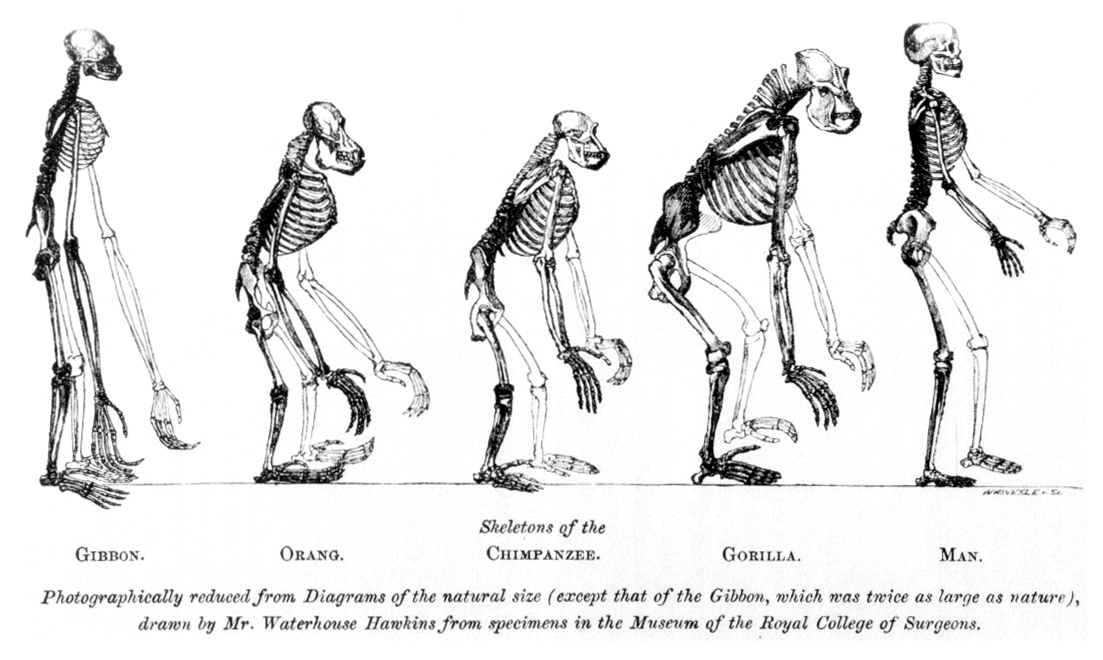 Pithecometra: In the frontispiece from his 1863 Evidence as to Man's Place in Nature, Thomas Huxley compared skeletons of apes to humans. Further information: Anthropology and Physical anthropology In 1784, Louis-Jean-Marie Daubenton, who wrote many comparative anatomy memoirs for the Académie française, published the Mémoire sur les différences de la situation du grand trou occipital dans l'homme et dans les animaux (which translates as Memoir on the Different Positions of the Occipital Foramen in Man and Animals). Six years later, Pieter Camper (1722–1789), distinguished both as an artist and as an anatomist, published some lectures containing an account of his craniometrical methods. These laid the foundation of all subsequent work.[8] Pieter Camper invented the "facial angle", a measure meant to determine intelligence among various species. According to this technique, a "facial angle" was formed by drawing two lines: one horizontally from the nostril to the ear; and the other perpendicularly from the advancing part of the upper jawbone to the most prominent part of the forehead. Camper claimed that antique statues presented an angle of 90°, Europeans of 80°, Black people of 70° and the orangutan of 58°, thus displaying a hierarchic view of mankind, based on a decadent conception of history. This scientific research was continued by Étienne Geoffroy Saint-Hilaire (1772–1844) and Paul Broca (1824–1880), founder of the Anthropological Society in 1859 in France. In 1856, workers found in a limestone quarry the skull of a Neanderthal man, thinking it to be the remains of a bear. They gave the material to amateur naturalist Johann Karl Fuhlrott, who turned the fossils over to anatomist Hermann Schaaffhausen. The discovery was jointly announced in 1857, giving rise to paleoanthropology. Measurements were first made to compare the skulls of men with those of other animals. This wide comparison constituted the first subdivision of craniometric studies.[8] The artist-anatomist Camper developed a theory to measure the facial angle, for which he is chiefly known in later anthropological literature. Camper's work followed 18th-century scientific theories. His measurements of facial angle were used to liken the skulls of non-Europeans to those of apes.  Selection of primate skulls "Craniometry" also played a role in the foundation of the United States and the ideologies or racism that would become ingrained in the American psyche. As John Jeffries articulates in The Collision of Culture the Anglo-American hegemony present in America during the eighteenth and nineteenth century helped establish "The American School of Craniometry" which helped establish the American and Western concept of race. As Jeffries points out the rigid establishment of race in eighteenth-century American society came from a new school of sciences which sought to distance Anglo-Saxons from the African American population. The distancing of the African population in American society through craniometry helped greatly in the efforts to scientifically prove they were inferior. The ideologies set forth by this new "American School" of thought were then used to justify maintaining an enslaved population to sustain the increasing number of slave plantations in the American South during the eighteenth and nineteenth centuries.[10] In the 19th century the names of notable contributors to the literature of craniometry quickly increased in number. While it is impossible to analyse each contribution, or even record a complete list of the names of the authors, notable researchers who used craniometric methods to compare humans to other animals included T. H. Huxley (1825–1895) of England and Paul Broca.[8] By comparing skeletons of apes to man, Huxley backed up Charles Darwin's theory of evolution and developed the "Pithecometra principle", which stated that man and ape were descended from a common ancestor. Ernst Haeckel (1834–1919) became famous for his now outdated "recapitulation theory", according to which each individual mirrored the evolution of the whole species during his life. Although outdated, his work contributed then to the examination of human life. These researches on skulls and skeletons helped liberate 19th-century European science from its ethnocentric biases.[11] In particular, Eugène Dubois' (1858–1940) discovery in 1891 in Indonesia of the "Java Man", the first specimen of Homo erectus to be discovered, demonstrated mankind's deep ancestry outside Europe. |
頭蓋計測学と人類学 ピテコメトラ:1863年に出版された著書『自然における人間の地位に関する証拠』の口絵で、トマス・ハックスリーは類人猿と人間の骨格を比較した。 詳細情報:人類学と自然人類学 1784年、フランス学士院のために多くの比較解剖学の回顧録を著したルイ=ジャン=マリー・ドーベントンが、『人間と動物における大後頭孔の位置の違い に関する覚書』(原題:Mémoire sur les différences de la situation du grand trou occipital dans l'homme et dans les animaux)を出版した。 その6年後、画家としても解剖学者としても著名なピーテル・カンペール(1722年~1789年)が、自身の頭蓋計測法に関する講義録を出版した。この講義録は、その後のすべての研究の基礎となった。[8] ピーター・カンペルは、さまざまな種の間で知性を測定するための尺度である「顔面角」を考案した。この手法によると、「顔面角」は2本の線を引くことで形成される。1本は鼻の穴から耳まで水平に、もう1本は上顎骨の前方部分から額の最も突出した部分まで垂直に引く。 カンペルは、古代の彫像は90°、ヨーロッパ人は80°、黒人は70°、オランウータンは58°の角度を示しており、これは退廃的な歴史観に基づく人間観 のヒエラルキーを示していると主張した。この科学的調査は、エティエンヌ・ジョフロワ・ド・サン=テグジュペリ(1772年~1844年)と、1859年 にフランスで人類学協会を創設したポール・ブローカ(1824年~1880年)によって続けられた。 1856年、石灰岩の採石場で働いていた労働者たちが、クマの死骸だと思い込んでネアンデルタール人の頭蓋骨を発見した。彼らはその材料をアマチュアの自 然科学者ヨハン・カール・フールロートに渡し、フールロートは化石を解剖学者ヘルマン・シャーフハウゼンに引き渡した。この発見は1857年に共同で発表 され、古生物人類学の誕生につながった。 まず、人間の頭蓋骨と他の動物の頭蓋骨を比較する測定が行われた。この広範な比較は、頭蓋計測学の最初の細分化となった。[8] 芸術家であり解剖学者でもあったカンペルは、顔の角度を測定する理論を展開し、その理論は後の人類学の文献で広く知られるようになった。 カンペルの研究は18世紀の科学理論に則ったものであった。彼の顔の角度の測定値は、ヨーロッパ人以外の頭蓋骨を類人猿のものと比較するために用いられた。  霊長類の頭蓋骨の(進化上の?)選択 「頭蓋計測学」は、アメリカ合衆国の建国や、アメリカ人の心理に根付くことになる人種差別思想の形成にも一役買った。ジョン・ジェフリーズは著書『文化の 衝突』の中で、18世紀から19世紀にかけてアメリカに存在した英米の覇権が「アメリカ頭蓋計測学派」の確立を助け、それがアメリカおよび西洋の「人種」 概念の確立につながったと述べている。ジェフリーズが指摘するように、18世紀のアメリカ社会における人種の固定化は、アフリカ系アメリカ人とアングロサ クソン系アメリカ人の距離を置こうとする新しい科学派から生まれた。頭蓋計測学によってアメリカ社会におけるアフリカ系住民を遠ざけることは、彼らが劣っ ていることを科学的に証明する取り組みに大いに役立った。この新しい「アメリカ学派」の思想が打ち出したイデオロギーは、18世紀から19世紀にかけてア メリカ南部で奴隷農園の数が増加する中、奴隷人口を維持することを正当化するために利用された。 19世紀には、頭蓋計測学の文献に貢献した著名な人物の名前が急速に増えていった。各々の貢献を分析することは不可能であり、また著者の名前の完全なリス トを記録することもできないが、頭蓋計測学の手法を用いて人間と他の動物を比較した著名な研究者の例としては、イギリスのT. H. ハクスリー(1825年~1895年)やポール・ブローカなどがいる。 ハクスリーは、類人猿と人間の骨格を比較することで、チャールズ・ダーウィンの進化論を裏付け、人間と類人猿は共通の祖先から進化したとする「ピテコムトラの原理」を打ち立てた。 エルンスト・ヘッケル(1834年~1919年)は、現在では時代遅れとなった「回帰説」で有名になった。それによると、個体は生涯にわたって種全体の進化を反映するという。時代遅れではあるが、彼の研究は当時、人間の生活の検証に貢献した。 頭蓋骨や骨格の研究は、19世紀のヨーロッパの科学をその民族中心主義的な偏見から解放することに貢献した。[11] 特に、1891年にインドネシアで「ジャワ原人」を発見したユージン・デュボワ(1858年~1940年)の功績は大きく、これはホモ・エレクトゥス属の 最初の標本であり、ヨーロッパ以外の地域にも人類の遠い祖先が存在することを証明した。 |
| Cranial capacity, races and 19th–20th-century scientific ideas Samuel George Morton (1799–1851), one of the inspirers of physical anthropology, collected hundreds of human skulls from all over the world and started trying to find a way to classify them according to some logical criterion. Influenced by the common theories of his time, he claimed that he could judge the intellectual capacity of a race by the cranial capacity (the measure of the volume of the interior of the skull). After inspecting three mummies from ancient Egyptian catacombs, Morton concluded that Caucasians and other races were already distinct three thousand years ago. Since the Bible indicated that Noah's Ark had washed up on Mount Ararat, only a thousand years ago before this, Morton claimed that Noah's sons could not possibly account for every race on Earth. According to Morton's theory of polygenism, races have been separate since the start.[12] Morton claimed that he could judge the intellectual capacity of a race by the skull size. A large skull meant a large brain and high intellectual capacity, and a small skull indicated a small brain and decreased intellectual capacity. Morton collected hundreds of human skulls from all over the world. By studying these skulls he claimed that each race had a separate origin. Morton had many skulls from ancient Egypt, and concluded that the ancient Egyptians were not African, but were White. His two major monographs were the Crania Americana (1839), An Inquiry into the Distinctive Characteristics of the Aboriginal Race of America and Crania Aegyptiaca (1844). Based on craniometry data, Morton claimed in Crania Americana that the Caucasians had the biggest brains, averaging 87 cubic inches, Indians were in the middle with an average of 82 cubic inches and Negroes had the smallest brains with an average of 78 cubic inches.[12] Stephen Jay Gould (1941–2002), an American paleontologist, evolutionary biologist and historian of science, studied these craniometric works in The Mismeasure of Man (1981) and claimed Samuel Morton had fudged data and "overpacked" the skulls with filler in order to justify his preconceived notions on racial differences. A subsequent study by the anthropologist John Michael found Morton's original data to be more accurate than Gould describes, concluding that "[c]ontrary to Gould's interpretation... Morton's research was conducted with integrity."[13] In 2011, physical anthropologists at the University of Pennsylvania, which owns Morton's collection, published a study that concluded that almost every detail of Gould's analysis was wrong and that "Morton did not manipulate his data to support his preconceptions, contra Gould." They identified and remeasured half of the skulls used in Morton's reports, finding that in only 2% of cases did Morton's measurements differ significantly from their own and that these errors either were random or gave a larger than accurate volume to African skulls, the reverse of the bias that Gould imputed to Morton.[14] Morton's followers, particularly Josiah C. Nott and George Gliddon in their monumental tribute to Morton's work, Types of Mankind (1854), carried Morton's ideas further and backed up his findings which supported the notion of polygenism. Charles Darwin opposed Nott and Glidon in his 1871 The Descent of Man, arguing for a monogenism of the species. Darwin conceived the common origin of all humans (the single-origin hypothesis) as essential for evolutionary theory. Furthermore, Josiah Nott was the translator of Arthur de Gobineau's An Essay on the Inequality of the Human Races (1853–1855), which is one of the founding works of the group of studies that segregates society based on "race", in contrast to Boulainvilliers' (1658–1722) theory of races. Henri de Boulainvilliers opposed the Français (French people), alleged descendants of the Nordic Franks, and members of the aristocracy, to the Third Estate, considered to be indigenous Gallo-Roman people who were subordinated by the Franks by right of conquest.[clarification needed] Gobineau, meanwhile, made three main divisions between races, based not on colour but on climatic conditions and geographic location, and which privileged the "Aryan" race. In 1873, Paul Broca (1824–1880) found the same pattern described by Samuel Morton's Crania Americana by weighing brains at autopsy. Other historical studies alleging a Black-White difference in brain size include Bean (1906), Mall, (1909), Pearl, (1934) and Vint (1934). 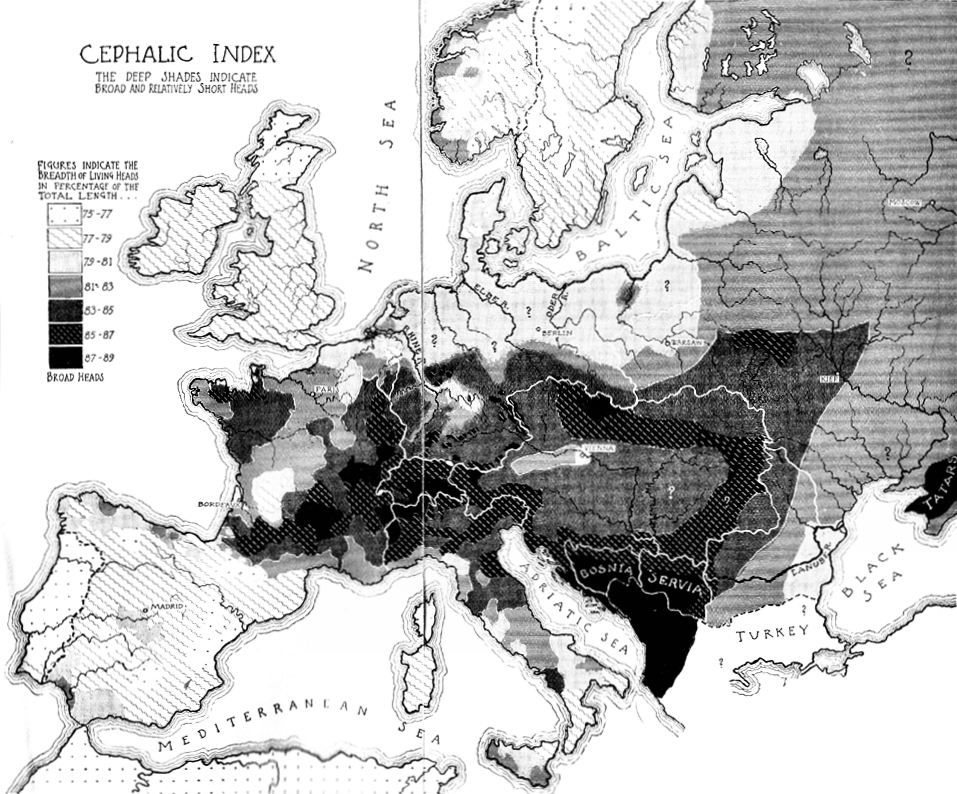 William Z. Ripley's map of the "cephalic index" in Europe, from The Races of Europe (1899) Furthermore, Georges Vacher de Lapouge's racial classification ("Teutonic", "Alpine" and "Mediterranean") was re-used by William Z. Ripley (1867–1941) in The Races of Europe (1899), who even made a map of Europe according to the alleged cephalic index of its inhabitants. In Germany, Rudolf Virchow launched a study of craniometry, which gave surprising results according to contemporary theories on the "Aryan race", leading Virchow to denounce the "Nordic mysticism" in the 1885 Anthropology Congress in Karlsruhe. Josef Kollmann, a collaborator of Virchow, stated in the same congress that the people of Europe, be them German, Italian, English or French, belonged to a "mixture of various races", furthermore declaring that the "results of craniology" led to "struggle against any theory concerning the superiority of this or that European race" on others.[15] Virchow later rejected measure of skulls as legitimate means of taxonomy. Paul Kretschmer quoted an 1892 discussion with him concerning these criticisms, also citing Aurel von Törok's 1895 work, who basically proclaimed the failure of craniometry.[15] |
頭蓋容量、人種、そして19世紀から20世紀にかけての科学的考え方 自然人類学の推進者の一人であるサミュエル・ジョージ・モートン(1799年~1851年)は、世界中から数百もの人間の頭蓋骨を集め、それらを論理的な 基準に基づいて分類する方法を見つけ出そうとし始めた。当時の一般的な理論に影響を受けたモートンは、頭蓋容量(頭蓋骨内部の容積の測定値)によって人種 の知的能力を判断できると主張した。 古代エジプトの地下墓から発掘された3体のミイラを調査した結果、モートンは、3000年前にはすでにコーカソイド人とその他の人種は区別されていたと結 論付けた。聖書によると、ノアの方舟がアララト山に漂着したのは1000年前のことであるため、ノアの息子たちが地球上のすべての民族を説明できるはずが ないとモートンは主張した。モートンの多起源説によると、人種は誕生以来、別々であったという。 モートンは、頭蓋骨の大きさによって人種の知的能力を判断できると主張した。大きな頭蓋骨は大きな脳と高い知的能力を意味し、小さな頭蓋骨は小さな脳と知 的能力の低下を示している。モートンは世界中から数百もの人間の頭蓋骨を集めた。これらの頭蓋骨を研究することで、モートンはそれぞれの種族が別々の起源 を持っていると主張した。モートンは古代エジプトの頭蓋骨を多数収集しており、古代エジプト人はアフリカ人ではなく白人であったと結論づけた。彼の主要な 研究論文は『アメリカ人の頭蓋骨』(1839年)、『アメリカ原住民の独特な特徴に関する調査』、『エジプト人の頭蓋骨』(1844年)の2つである。 モートンは頭蓋計測学のデータに基づいて、『アメリカ人の頭蓋骨』の中で、コーカソイドの脳が最も大きく平均87立方インチであること、インディアンは平均82立方インチで中間であること、そしてネグロイドの脳が最も小さく平均78立方インチであることを主張した。 スティーブン・ジェイ・グールド(1941年 - 2002年)は、アメリカの古生物学者、進化生物学者、科学史家であり、『人間の誤測定』(1981年)でこれらの頭蓋計測学の研究を取り上げ、サミュエ ル・モートンが人種間の差異に関する先入観を正当化するためにデータを改ざんし、頭蓋骨を詰め物で「詰め込み過ぎ」にしたと主張した。人類学者ジョン・マ イケルによるその後の研究では、モートンの元データはグールドの記述よりも正確であることが判明し、「グールドの解釈とは逆に、モートンの研究は誠実に行 われた」と結論づけている[13]。 2011年には、モートンのコレクションを所有するペンシルベニア大学の自然人類学者たちが、グールドの分析のほぼすべての詳細が誤りであり、「モートン はグールドとは逆に、先入観を裏付けるためにデータを操作したわけではない」という結論の研究を発表した。彼らはモートンの報告書で使用された頭蓋骨の半 分を特定し、再測定したところ、モートンの測定値が彼らの測定値と著しく異なるのはわずか2%のケースのみであり、これらの誤差はランダムであるか、アフ リカ人の頭蓋骨の容積を正確な値よりも大きく見積もっていることが判明した。これは、モートンに偏見があったとグールドが指摘したことの逆である。 [14] モートンの信奉者、特にジョサイア・C・ノットとジョージ・グリドンは、モートンの業績への記念碑的な賛辞である著書『人類の類型』(1854年)の中で、モートンの考えをさらに推し進め、多系説を支持するモートンの発見を裏付けた。 チャールズ・ダーウィンは1871年の著書『人間の由来』で、ノットとグリドンに反対し、種の単源説を主張した。ダーウィンは、進化論には全人類の共通の起源(単一起源説)が不可欠であると考えた。 さらに、ジョサイア・ノットは、人種に基づく社会の隔離を唱える学派の基礎を築いた研究のひとつである、アルチュール・ド・ゴビノーの『人種不平等論』 (1853年~1855年)の翻訳者であった。これは、アンリ・ド・ブルアンヴィリエ(1658年~1722年)の人種理論とは対照的である。アンリ・ ド・ブールボンヴィリエは、征服権によりフランク人に従属させられた先住のガリア・ローマ人であるとみなされる第三身分のフランス人(フランス国民)と貴 族階級を、北欧フランク人の子孫とされるフランス人に反対した。一方、ゴビノーは、肌の色ではなく気候条件と地理的位置に基づいて人種を3つの主要なグ ループに分類し、「アーリア人」を優遇した。 1873年、ポール・ブローカ(1824年 - 1880年)は、サミュエル・モートン著『アメリカ人の頭蓋骨』で述べられたのと同じパターンを、死体解剖で脳を計測することで発見した。脳の大きさにお ける黒人と白人の違いを主張するその他の歴史的研究には、ビーン(1906年)、モール(1909年)、パール(1934年)、ヴィント(1934年)な どがある。  ウィリアム・Z・リプリーの著書『ヨーロッパの人種』(1899年)に掲載されたヨーロッパにおける「頭蓋指数」の地図 さらに、ジョルジュ・ヴァシェール・ド・ラプージュ(Georges Vacher de Lapouge)による人種分類(「チュートン人」、「アルプス人」、「地中海人」)は、ウィリアム・Z・リプリー(William Z. Ripley、1867年~1941年)によって『ヨーロッパの人種』(1899年)で再び使用され、リプリーはヨーロッパ住民の頭蓋指数とされるものに 従ってヨーロッパの地図まで作成した。 ドイツでは、ルドルフ・ウィルヒョーが頭蓋計測学の研究を開始し、当時の「アーリア人種」に関する理論に反する驚くべき結果が得られたため、ウィルヒョーは1885年のカールスルーエ人類学会議で「北欧神秘主義」を非難した。 ヴィルヒョウの協力者であったヨーゼフ・コルマンは、同会議において、ドイツ人、イタリア人、イギリス人、フランス人など、ヨーロッパの人々は「さまざま な人種の混合」に属していると述べ、さらに「頭蓋学の結果」は、他のヨーロッパ人種に関する優越性理論に対する「闘争」につながったと主張した。 その後、ヴィルヒョウは頭蓋骨の測定を分類学上の正当な手段として否定した。ポール・クレッチュマーは、これらの批判に関する1892年のヴィルヒョウと の議論を引用し、また、基本的に頭蓋計測学の失敗を宣言した1895年のアウレル・フォン・テオロクの著作も引用している。[15] |
| Craniometry, phrenology and physiognomy Further information: Phrenology, Physiognomy, and Anthropological criminology Craniometry was also used in phrenology, which purported to determine character, personality traits, and criminality on the basis of the shape of the head and thus of the skull. At the turn of the 19th century, Franz Joseph Gall (1758–1822) developed "cranioscopy" (Ancient Greek kranion: skull, scopos: vision), a method to determine the personality and development of mental and moral faculties on the basis of the external shape of the skull. Cranioscopy was later renamed to phrenology (phrenos: mind, logos: study) by his student Johann Spurzheim (1776–1832), who wrote extensively on the "Drs. Gall and Spurzheim's physiognomical System". Physiognomy claimed a correlation between physical features (especially facial features) and character traits. It was made famous by Cesare Lombroso (1835–1909), the founder of anthropological criminology, who claimed to be able to scientifically identify links between the nature of a crime and the personality or physical appearance of the offender. The originator of the concept of a "born criminal" and arguing in favor of biological determinism, Lombroso tried to recognize criminals by measurements of their bodies. He concluded that skull and facial features were clues to genetic criminality, and that these features could be measured with craniometers and calipers with the results developed into quantitative research. A few of the 14 identified traits of a criminal included large jaws, forward projection of jaw, low sloping forehead; high cheekbones, flattened or upturned nose; handle-shaped ears; hawk-like noses or fleshy lips; hard shifty eyes; scanty beard or baldness; insensitivity to pain; long arms, and so on. |
頭蓋計測学、骨相学、人相学 詳細情報:骨相学、人相学、人類学的犯罪学 頭蓋計測学は骨相学にも用いられ、頭部、ひいては頭蓋骨の形状に基づいて性格、人格特性、犯罪性を判断するものとされていた。19世紀の変わり目に、フラ ンツ・ヨーゼフ・ガル(1758年~1822年)は、頭蓋骨の外形に基づいて人格や精神・道徳的能力の発達を判断する方法である「頭蓋鏡法」(古代ギリ シャ語のkranion:頭蓋骨、scopos:視覚)を開発した。 後に、弟子のヨハン・スプルツハイム(1776年~1832年)が「ガル博士とスプルツハイム博士の人相学体系」について広範にわたって著述したことによ り、クレニオスコピーは「フレノロジー(phrenology)」と改名された。人相学は、身体的特徴(特に顔の特徴)と性格的特徴の相関性を主張する学 問である。 人類学的犯罪学の創始者であるチェザーレ・ロンブローゾ(1835~1909)によって有名になった。ロンブローゾは、犯罪の性質と犯罪者の性格や外見と の関連性を科学的に特定できると主張した。「生まれながらの犯罪者」という概念の創始者であり、生物学的決定論を支持するロンブローゾは、犯罪者を身体測 定によって特定しようとした。 彼は、頭蓋骨や顔の特徴が遺伝的な犯罪性を示す手がかりとなり、それらの特徴は、頭部測定器やノギスで測定でき、その結果を定量的な研究に発展させること ができると結論づけた。犯罪者の特徴として特定された14の特性のうちのいくつかには、大きな顎、顎の前方突出、傾斜の緩い額、高い頬骨、平らな鼻または 上向きの鼻、柄のような耳、鷹のような鼻または厚い唇、ぎょろぎょろした目、薄い髭または禿頭、痛みに鈍感、長い腕などが含まれる。 |
Criticisms and revival of past cranial theories in the 20th century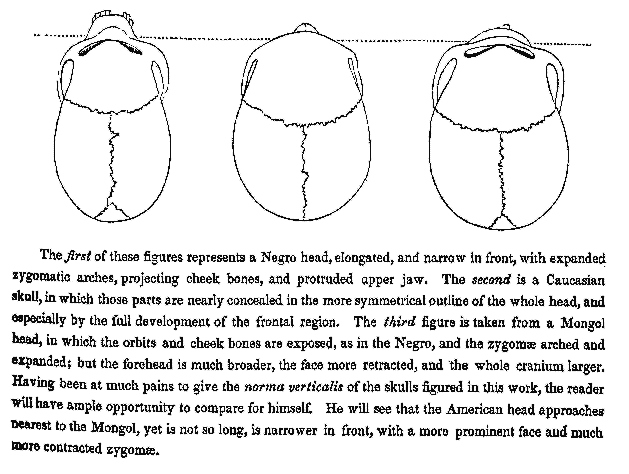 An 1839 drawing by Samuel George Morton of "a Negro head… a Caucasian skull… a Mongol head." After being a main influence of US white nationalists, William Ripley's The Races of Europe (1899) was eventually rewritten in 1939, just before World War II, by Harvard physical anthropologist Carleton S. Coon.[citation needed] J. Philippe Rushton, psychologist and author of the controversial work Race, Evolution and Behavior (1995), reanalyzed Gould's retabulation in 1989, and argued that Samuel Morton, in his 1839 book Crania Americana, had shown a pattern of decreasing brain size proceeding from East Asians to Europeans to Africans. In his 1995 book Race, Evolution, and Behavior, Rushton alleged an average endocranial volume of 1,364 cm3 for East Asians, 1,347 for white caucasians and 1,268 for black Africans. Other similar claims were previously made by Ho et al. (1980), who measured 1,261 brains at autopsy, and Beals et al. (1984), who measured approximately 20,000 skulls, finding the same East Asian → European → African pattern. However, in the same article Beals explicitly warns against using the findings as indicative of racial traits, "If one merely lists such means by geographical region or race, causes of similarity by genogroup and ecotype are hopelessly confounded".[16] Rushton's findings have also been criticized for questionable methodology, such as lumping in African-Americans with equatorial Africans, as people from hot climates generally have slightly smaller crania.[17] Rushton also compared equatorial Africans from the poorest and least educated areas of Africa against Asians from the wealthiest and most educated areas of Asia and areas with colder climates which generally induce larger cranium sizes in evolution.[17] According to Zack Cernovsky, from one of Rushton's own study it emerges that the average cranial capacity for North American blacks is similar to the average for Caucasians from comparable climatic zones.[17][18] Per Cernovsky, people from different climates tend to have minor differences in brain size, but these do not necessarily imply differences in intelligence; for instance, though women tend to have smaller brains than men they also have more neural complexity and loading in certain areas of the brain than men.[19][20] |
20世紀における過去の頭蓋説への批判と復活 サミュエル・ジョージ・モートンによる1839年の「黒人の頭部…白人の頭蓋骨…モンゴロイドの頭部」の図 米国の白人ナショナリストたちに大きな影響を与えたウィリアム・リプリーの『ヨーロッパの民族』(1899年)は、最終的に第二次世界大戦直前の1939年にハーバード大学の自然人類学者カールトン・S・クーンによって書き換えられた。[要出典] 心理学者で物議を醸した著書『人種、進化と行動』(1995年)の著者であるJ.フィリップ・ルシトンは、1989年にグールドの再調査を行い、サミュエ ル・モートンが1839年の著書『アメリカ人の頭蓋骨』で、東アジア人からヨーロッパ人、アフリカ人へと脳のサイズが減少するパターンを示したと主張し た。 1995年の著書『人種、進化、行動』の中で、ラストンは東アジア人の平均頭蓋内容積を1,364 cm3、白人コーカソイドを1,347、黒人アフリカ人を1,268と主張した。同様の主張は、以前にもホーら(1980年)によってなされており、彼ら は1,261個の脳を解剖して測定し、ビーズら(1984年)は約20,000個の頭蓋骨を測定し、同じ東アジア→ヨーロッパ→アフリカのパターンを見出 した。しかし、同じ論文の中で、Bealsは、この調査結果を人種的特徴を示すものとして用いることに対して明確に警告している。「もし、単に地理的地域 や人種別にこのような手段を列挙するだけなら、遺伝子群や生態型による類似の原因は、絶望的に混同されてしまうだろう」[16] また、ラシュトンの調査結果は、その方法論に疑問があるとして批判されている。例えば、アフリカ系アメリカ人と赤道アフリカ人をひとまとめにしていること などである。暑い気候の地域の人々は 一般的に熱帯気候の地域の人々は頭蓋骨がやや小さい。[17] ラスストンはまた、アフリカの最貧で教育水準の最も低い地域の赤道アフリカ人と、アジアの最も富裕で教育水準の高い地域および一般的に進化において頭蓋骨 のサイズが大きくなる寒冷気候の地域のアジア人を比較した。[17] ザック・セルノフスキーによると、ラスストンの研究のひとつでは、北米の黒人の平均頭蓋容量は 同等の気候帯の白人の平均値と類似していることが判明した。[17][18] セルノフスキーによると、気候の異なる人々は脳の大きさに若干の違いがある傾向にあるが、必ずしも知能の差を意味するわけではない。例えば、女性は男性よ りも脳が小さい傾向にあるが、神経の複雑性や脳の特定の領域における負荷は男性よりも高い。[19][20] |
| Modern use More direct measurements involve examinations of brains from corpses, or more recently, imaging techniques such as MRI, which can be used on living persons. Such measurements are used in research on neuroscience and intelligence. Brain volume data and other craniometric data are used in mainstream science to compare modern-day animal species, and to analyze the evolution of the human species in archaeology. Measurements of the skull based on specific anatomical reference points are used in both forensic facial reconstruction and portrait sculpture.[citation needed] |
現代における使用 より直接的な測定には、死体から採取した脳の検査、または最近ではMRIなどの画像技術(生体にも使用可能)が含まれる。このような測定は、神経科学や知能の研究で使用されている。 脳容積データやその他の頭蓋計測データは、現代の動物種の比較や、考古学における人類の進化の分析に主流の科学で使用されている。 特定の解剖学的基準点に基づく頭蓋の計測値は、法医学的な顔の復元と肖像彫刻の両方に使用されている。[要出典] |
| Anthropometry Cranial vault Craniofacial anthropometry Forensic anthropology Neuroscience and intelligence Samuel George Morton Theodor Kocher, inventor of the craniometer[21] Typology (anthropology) |
人体計測学 頭蓋底 頭蓋顔面人体計測学 法医学人類学 神経科学と知能 サミュエル・ジョージ・モートン 頭蓋計測器の発明者であるテオドール・コッホ[21] 類型学(人類学) |
| https://en.wikipedia.org/wiki/Craniometry |
|
The cephalic index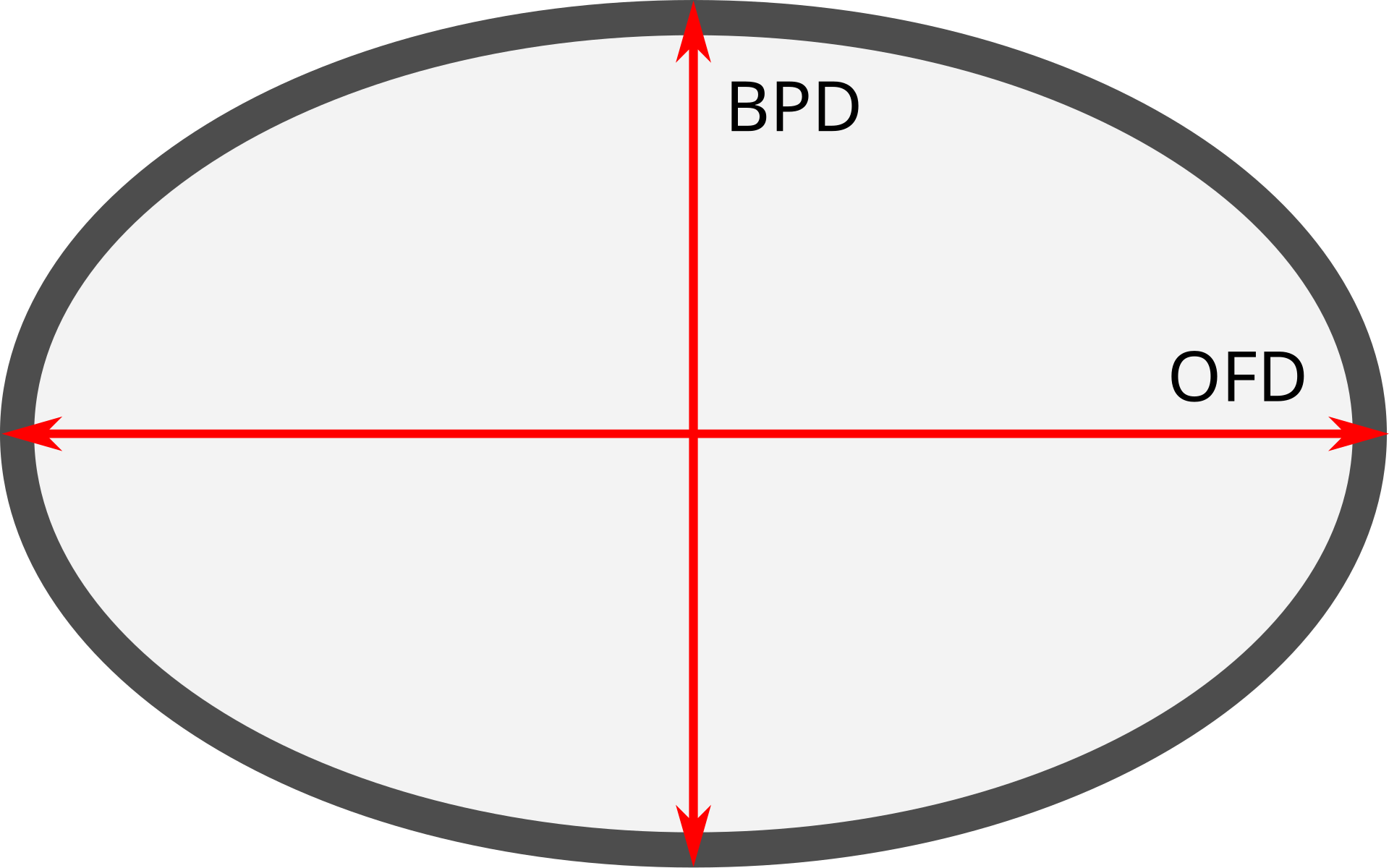 Cephalic index viewed from above the head |
頭蓋指数 頭頂部から見た頭部指数 |
| The cephalic index or cranial
index is a number obtained by taking the maximum width (biparietal
diameter or BPD, side to side) of the head of an organism, multiplying
it by 100 and then dividing it by their maximum length (occipitofrontal
diameter or OFD, front to back). The index was once used to categorize
human beings in the first half of the 20th century, but today it is
used to categorize dogs and cats. Historic use in anthropology Early anthropology 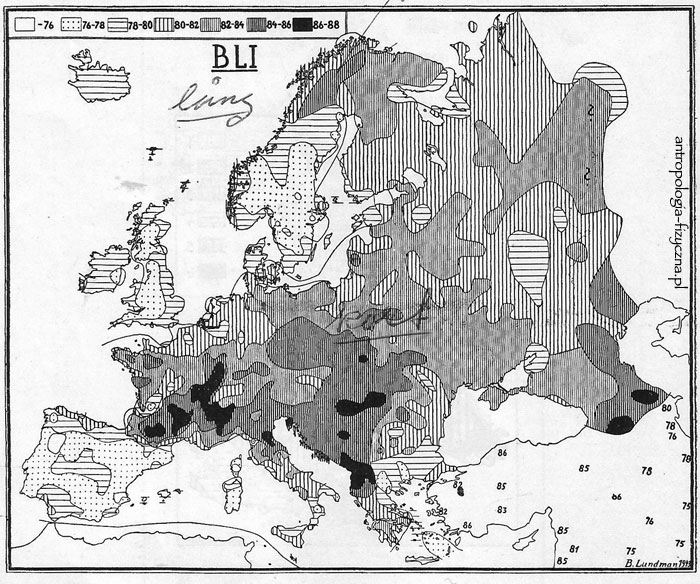 Cephalic index map of Europe by Bertil Lundman The cephalic index was used by anthropologists in the early 20th century as a tool to categorize human populations. It was used to describe an individual's appearance and for estimating the age of fetuses for legal and obstetrical reasons. The cephalic index was defined by Swedish professor of anatomy Anders Retzius (1796–1860) and first used in physical anthropology to classify ancient human remains found in Europe. The theory became closely associated with the development of racial anthropology in the 19th and early 20th centuries, when historians attempted to use ancient remains to model population movements in terms of racial categories. American anthropologist Carleton S. Coon also used the index in the 1960s, by which time it had been largely discredited. 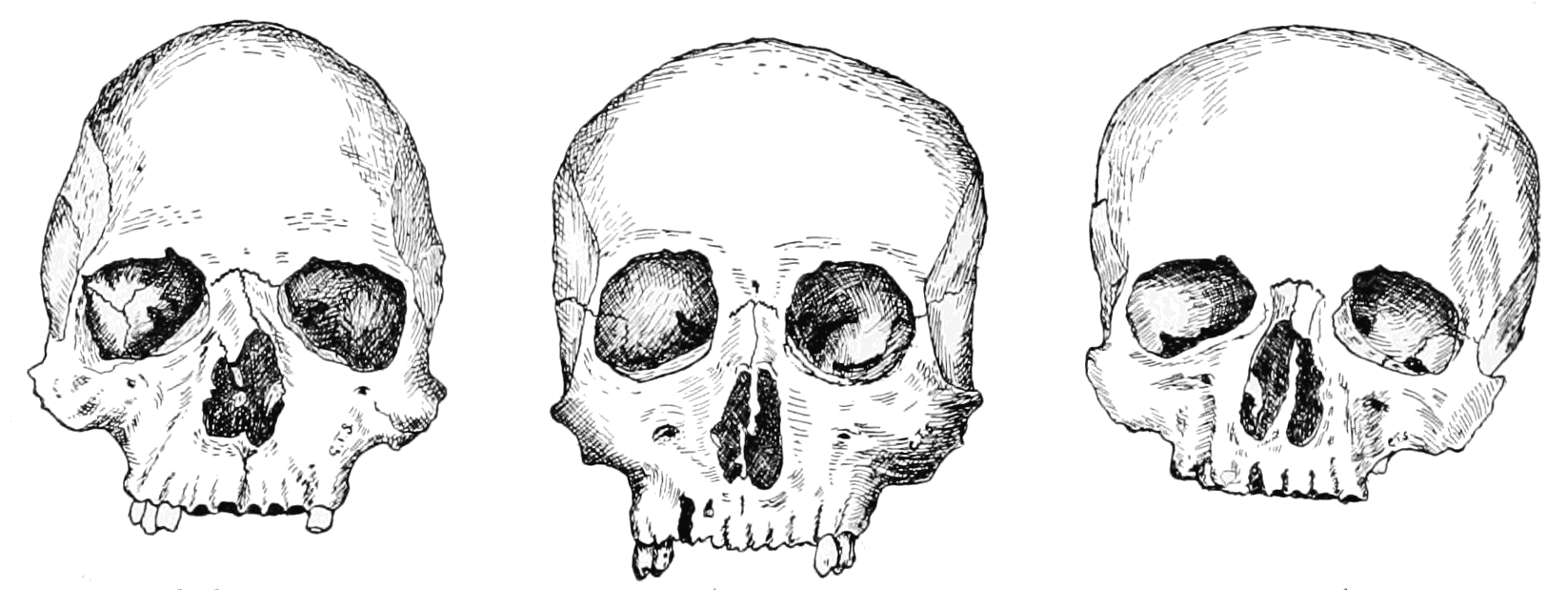 Cephalic indexes of skull shapes. Long skull (left) – cephalic index 71.4; tall skull (center) – cephalic index 81; broad skull (right) – cephalic index 85 In the cephalic index model, human beings were characterized by having either a dolichocephalic (long-headed), mesaticephalic (moderate-headed), or brachycephalic (short-headed) cephalic index or cranial index. The children of the Tsar Nicholas II of Russia in June 1917, with loss of hair after fighting measles: among them, Tatiana had the skull with least cephalic index. Indices 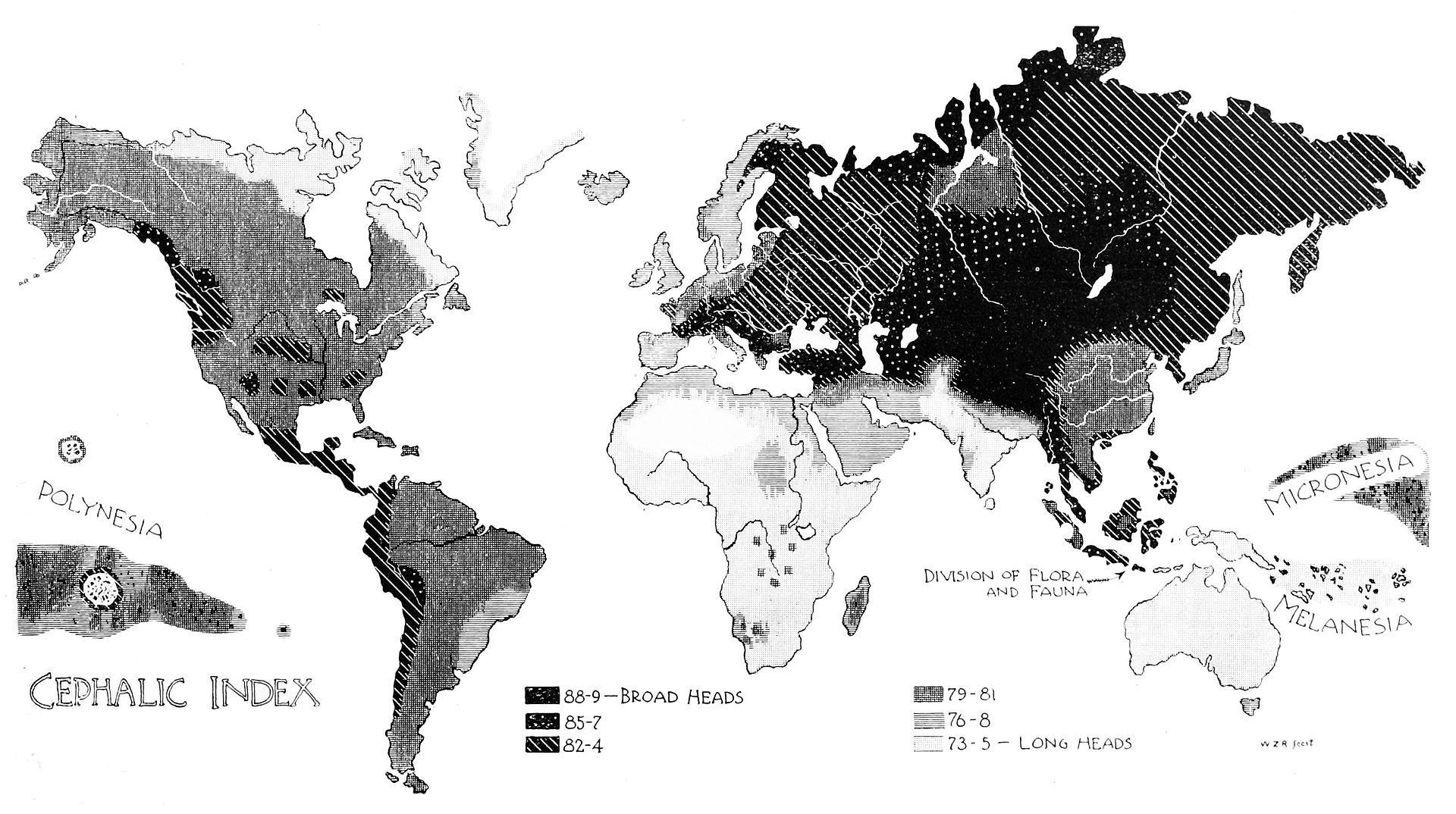 1896 world cephalic index map Cephalic indices are grouped as in the following table: 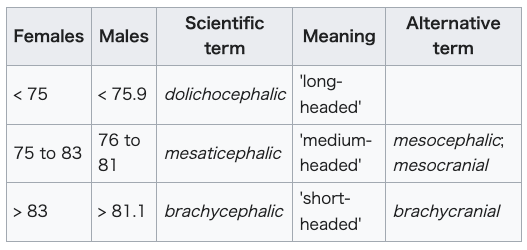 Females Males Scientific term Meaning Alternative term < 75 < 75.9 dolichocephalic 'long-headed' 75 to 83 76 to 81 mesaticephalic 'medium-headed' mesocephalic; mesocranial > 83 > 81.1 brachycephalic 'short-headed' brachycranial Technically, the measured factors are defined as the maximum width of the bones that surround the head above the supramastoid crest (behind the cheekbones), and the maximum length from the most easily noticed part of the glabella (between the eyebrows) to the most easily noticed point on the back part of the head. Controversy The usefulness of the cephalic index was questioned by Giuseppe Sergi, who argued that cranial morphology provided a better means to model racial ancestry.[1] Also, Franz Boas studied the children of immigrants to the United States in 1910 to 1912, noting that the children's cephalic index differed significantly from their parents', implying that local environmental conditions had a significant effect on the development of head shape.[2] Boas argued that if craniofacial features were so malleable in a single generation, then the cephalic index was of little use for defining race and mapping ancestral populations. Scholars such as Earnest Hooton continued to argue that both environment and heredity were involved. Boas did not himself claim it was totally plastic. In 2002, a paper by Sparks and Jantz re-evaluated some of Boas's original data using new statistical techniques and concluded that there was a "relatively high genetic component" of head shape.[3] Ralph Holloway of Columbia University argues that the new research raises questions about whether the variations in skull shape have "adaptive meaning and whether, in fact, normalizing selection might be at work on the trait, where both extremes, hyperdolichocephaly and hyperbrachycephaly, are at a slight selective disadvantage."[2] In 2003, anthropologists Clarence C. Gravlee, H. Russell Bernard, and William R. Leonard reanalyzed Boas's data and concluded that most of Boas's original findings were correct. Moreover, they applied new statistical, computer-assisted methods to Boas's data and discovered more evidence for cranial plasticity.[4] In a later publication, Gravlee, Bernard and Leonard reviewed Sparks's and Jantz's analysis. They argue that Sparks and Jantz misrepresented Boas's claims, and that Sparks's and Jantz's data support Boas. For example, they point out that Sparks and Jantz look at changes in cranial size in relation to how long an individual has been in the United States in order to test the influence of the environment. Boas, however, looked at changes in cranial size in relation to how long the mother had been in the United States. They argue that Boas's method is more useful, because the prenatal environment is a crucial developmental factor.[4] Jantz and Sparks responded to Gravlee et al., reiterating that Boas' findings lacked biological meaning, and that the interpretation of Boas' results common in the literature was biologically inaccurate.[5] In a later study, the same authors concluded that the effects Boas observed were likely the result of population-specific environmental effects such as changes in cultural practices for cradling infants, rather than the effects of a general "American environment" which caused populations in America to converge to a common cranial type, as Boas had suggested.[6][7] Vertical cephalic index The vertical cephalic index, also known as the length-height index, was a less-commonly measured head ratio.[8][9] In the vertical cephalic index model, humans beings were characterized by having either a chamaecranic (low-skulled), orthocranic (medium high-skulled), or hypsicranic (high-skulled) cephalic index or cranial index. Medicine The cephalic index is also used in medicine, especially in the planning and effectiveness analysis of cranial deformity corrections.[10] The index is a useful tool in assessing the morphology of cranial deformities in clinical settings.[11] The index is used while looking at the fetal head shape, and can change in certain situations (ex. breech presentation, ruptured membranes, twin pregnancy).[12] |
頭部指数または頭蓋指数は、生物の頭部の最大幅(左右の頭頂間径または
BPD)を100倍し、その値を最大長(前頭後頭間径またはOFD、前後)で割った数値である。この指数は、20世紀前半には人間を分類するために使用さ
れていたが、現在では犬や猫の分類に使用されている。 人類学における歴史的な使用 初期の人類学  ベルティル・ルンドマンによるヨーロッパの頭部指数地図 頭部指数は、20世紀初頭の人類学者が人類集団を分類するツールとして使用していた。 また、法的な理由や産科的な理由から、個人の外見を説明したり、胎児の年齢を推定したりする目的でも使用されていた。 頭部指数はスウェーデンの解剖学者アンデシュ・レティウス(Anders Retzius、1796年~1860年)によって定義され、ヨーロッパで発見された古代の人骨を分類するために自然人類学で初めて使用された。この理論 は、19世紀から20世紀初頭にかけての人種人類学の発展と密接に関連するようになった。歴史家たちは古代の人骨を人種カテゴリーにおける人口移動のモデ ルとして使用しようとしたのである。また、1960年代には、アメリカの自然人類学者カールトン・S・クーンもこの指数を使用したが、その頃にはすでにこ の指数はほとんど信用されていなかった。  頭蓋形状の頭部指数。 長い頭蓋(左) - 頭部指数71.4、高い頭蓋(中央) - 頭部指数81、幅広い頭蓋(右) - 頭部指数85 頭部指数モデルでは、人間は長頭型(長頭)、中頭型(中程度の頭)、短頭型(短頭)の頭部指数または頭蓋指数のいずれかを持つと特徴付けられた。 1917年6月、はしかを患い脱毛したロシア皇帝ニコライ2世の子供たち:その中では、タチアナの頭蓋骨は最も頭長指数が低かった。 指数  1896年世界頭長指数地図 頭長指数は以下の表のように分類される:  女性 男性 科学用語 意味 代替用語 75未満 75.9未満 細長い頭蓋骨 「長頭」 75~83 76~81 中程度の頭蓋骨 「中頭」 中頭蓋骨 > 83 > 81.1 短頭型 短頭型 厳密には、測定される要素は、頬骨の後ろにある顎二腹筋上隆起部(supramastoid crest)の上の頭部を囲む骨の最大幅、および額の最も目立つ部分(眉間)から頭の後部の最も目立つ部分までの最大長と定義される。 論争 頭部指数の有用性については、ジュゼッペ・セルジ(Giuseppe Sergi)が疑問を呈し、頭蓋形態の方が人種の祖先をモデル化するより良い手段であると主張した。[1] また、フランツ・ボアズ(Franz Boas)は1910年から1912年にかけて米国への移民の子供たちを研究し、子供の頭部指数は両親の指数と著しく異なっていることを指摘し、頭部の形 状の発達にはその地域の環境条件が大きな影響を与えることを示唆した。[2] ボアスは、頭蓋顔面の形状が単一世代でこれほどまでに変化するのなら、頭部指数は人種を定義したり祖先集団をマッピングしたりするのにほとんど役立たない だろうと主張した。アーネスト・フートンなどの学者は、環境と遺伝の両方が関与していると主張し続けた。ボアス自身は、それが完全に可塑的であるとは主張 しなかった。 2002年、スパークスとジャンツによる論文では、新しい統計的手法を用いてボアズのオリジナルデータのいくつかを再評価し、頭部の形状には「比較的高い 遺伝的要素」があるという結論に達した。[3] コロンビア大学のラルフ・ホロウェイは、新しい研究は 頭蓋骨の形状の変化には「適応的な意味があるのか、また、実際、正規化選択がその形質に作用している可能性があるのか、そして、極端な長頭型と短頭型の両 方がわずかに選択的に不利であるのか」という疑問を提起している。 2003年、人類学者のクラレンス・C・グラブリー、H・ラッセル・バーナード、ウィリアム・R・レオナルドはボアズのデータを再分析し、ボアズの当初の 調査結果のほとんどが正しいと結論付けた。さらに、彼らはボアズのデータに新しい統計的、コンピュータ支援の手法を適用し、頭蓋骨の可塑性に関するさらな る証拠を発見した。[4] その後の出版物で、グラブリー、バーナード、レオナルドはスパークスとジャンツの分析を検証した。彼らは、スパークスとジャンツがボアスの主張を誤って表 現しており、スパークスとジャンツのデータはボアスの主張を裏付けていると主張している。例えば、彼らは、スパークスとジャンツが環境の影響を検証するた めに、個人が米国に滞在している期間と頭蓋骨のサイズの変化を関連付けて調べていることを指摘している。しかし、ボアスは母親が米国に滞在している期間と 頭蓋骨のサイズの変化を関連付けて調べている。出生前の環境は発育において重要な要因であるため、ボアスの方法の方がより有用であると彼らは主張してい る。[4] JantzとSparksはGravleeらの論文に反論し、ボアスの研究結果には生物学的な意味が欠けていること、また、文献で一般的に見られるボアス の研究結果の解釈は生物学的に不正確であることを改めて主張した。[5] その後の研究で、同じ著者らは、ボアスが観察した効果は ボアスが示唆したような「アメリカ環境」の影響によるものではなく、むしろ、アメリカにおける人口が共通の頭蓋タイプに収束した原因となった、乳児をあや す際の文化的な慣習の変化といった、特定の集団に特有な環境の影響によるものである可能性が高いと結論づけている。[6][7] 垂直頭部指数 垂直頭部指数は、長さと高さの指数としても知られており、あまり一般的ではない頭部比率の測定法であった。[8][9] 垂直頭部指数モデルでは、人間は、低頭位(低頭蓋)、正位(中程度の高頭蓋)、または高頭位(高頭蓋)の頭部指数または頭蓋指数を持つという特徴があっ た。 医学 頭部指数は医学でも用いられ、特に頭蓋変形矯正の計画や効果分析に用いられる。[10] この指数は臨床現場における頭蓋変形の形態評価に有用なツールである。[11] この指数は胎児の頭部の形状を観察する際に用いられるが、特定の状況(逆子、羊水破水、双胎妊娠など)では変化する可能性がある。[12] |
| https://en.wikipedia.org/wiki/Cephalic_index |
|
リ ンク
文 献
そ の他の情報
Copyleft, CC, Mitzub'ixi Quq Chi'j, 1996-2099
☆
 ☆
☆